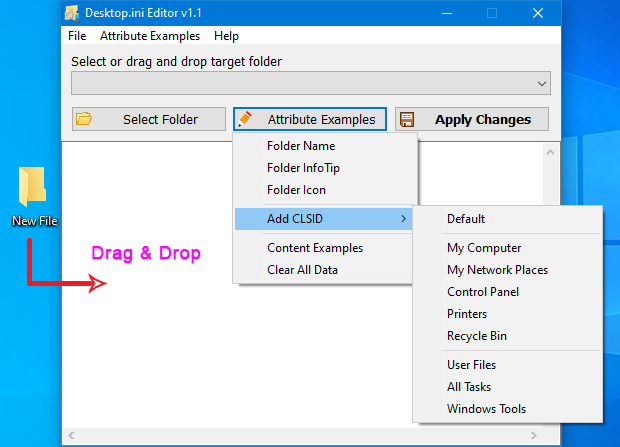

If you have deleted all the desktop.ini files, then restart your computer. If these files contain the lines, right-click on the file, then click Delete to remove all of them.

Once located, check whether the files contain “ %SystemRoot%\system32\shell32.dll,-21787”
drive:->Documents and Settings->All Users->Start Menu. drive:->Documents and Settings->All Users->Start Menu->Programs->Startup.  drive:->Documents and Settings->All Users->Start Menu->Programs.
drive:->Documents and Settings->All Users->Start Menu->Programs.  Locate all the files named Desktop.ini which have the same statement earlier in the document, to locate follow these steps:. Remove the checkmark beside both the options, then click Apply and OK to make the changes. Under Advanced Settings, locate Hide extensions for known file types & Hide protected operating system files. Click View tab and then click Options->Change folders & Search Options. Press Windows and E to get Windows Explorer. To locate desktop.ini file in your computer and delete it, follow these steps: So, now you know why you get that weird Notepad thing opening at the screen. For information about FileSystemObject object, see Dino Esposito, "Understanding VBScript: Manipulating Files with FileSystemObject," January 2000.You will see %SystemRoot%\system32\shell32.dll,-21787. For information about VBScript classes, see Dino Esposito, "Importing and Porting Classes in VBScript 5.0," January 2000. įinally, if you want to create a parser from scratch, you can create a VBScript class that uses the Scripting Runtime Library's FileSystemObject object. These components use the WriteProfileString API. If you don't want to use Perl, check out the wshadmin.dll and wshini.dll freeware components, which you can use with any Windows Script Host (WSH)-enabled scripting language. You can download the module and find usage instructions at. If you're not opposed to using Perl, the Win32::AdminMisc module provides ReadINI and WriteINI functions. wrap the APIs into a Windows Script Components (WSC) object that uses Perl to access the Win32 API. wrap the APIs into a scriptable Microsoft Visual Basic (VB) COM component. don't use those APIs but instead use the Scripting Runtime Library's TextStream object and parse the extracted information. However, I discovered those APIs are inaccessible with VBScript code. ini files without having to parse the extracted information. Initially, I wanted to use the GetPrivateProfileString and WritePrivate-ProfileString APIs with VBScript so that I could easily read and write to the. ini files by extracting server information from a database and inserting that information into a template. Do you have a scripting-related question or problem? You can send your question or problem to
Locate all the files named Desktop.ini which have the same statement earlier in the document, to locate follow these steps:. Remove the checkmark beside both the options, then click Apply and OK to make the changes. Under Advanced Settings, locate Hide extensions for known file types & Hide protected operating system files. Click View tab and then click Options->Change folders & Search Options. Press Windows and E to get Windows Explorer. To locate desktop.ini file in your computer and delete it, follow these steps: So, now you know why you get that weird Notepad thing opening at the screen. For information about FileSystemObject object, see Dino Esposito, "Understanding VBScript: Manipulating Files with FileSystemObject," January 2000.You will see %SystemRoot%\system32\shell32.dll,-21787. For information about VBScript classes, see Dino Esposito, "Importing and Porting Classes in VBScript 5.0," January 2000. įinally, if you want to create a parser from scratch, you can create a VBScript class that uses the Scripting Runtime Library's FileSystemObject object. These components use the WriteProfileString API. If you don't want to use Perl, check out the wshadmin.dll and wshini.dll freeware components, which you can use with any Windows Script Host (WSH)-enabled scripting language. You can download the module and find usage instructions at. If you're not opposed to using Perl, the Win32::AdminMisc module provides ReadINI and WriteINI functions. wrap the APIs into a Windows Script Components (WSC) object that uses Perl to access the Win32 API. wrap the APIs into a scriptable Microsoft Visual Basic (VB) COM component. don't use those APIs but instead use the Scripting Runtime Library's TextStream object and parse the extracted information. However, I discovered those APIs are inaccessible with VBScript code. ini files without having to parse the extracted information. Initially, I wanted to use the GetPrivateProfileString and WritePrivate-ProfileString APIs with VBScript so that I could easily read and write to the. ini files by extracting server information from a database and inserting that information into a template. Do you have a scripting-related question or problem? You can send your question or problem to








 0 kommentar(er)
0 kommentar(er)
